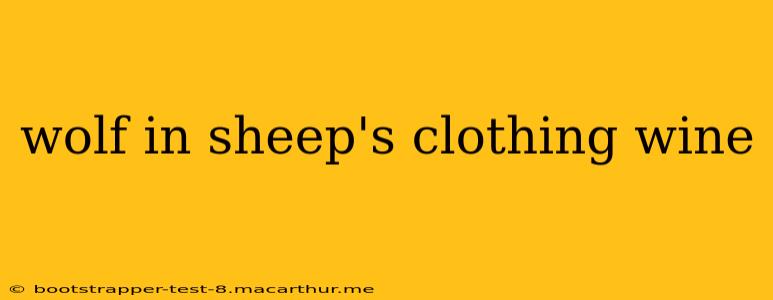The phrase "wolf in sheep's clothing" evokes a sense of betrayal and deception. In the world of wine, this idiom takes on a new meaning, referring to wines that appear to be something they're not. This can manifest in several ways, from misleading labels and marketing to actual winemaking practices that aim to mask inferior qualities. Let's explore the various ways a wine can be a "wolf in sheep's clothing" and how to avoid falling prey to deceptive practices.
What Makes a Wine a "Wolf in Sheep's Clothing"?
A "wolf in sheep's clothing" wine isn't necessarily bad wine, but it's wine that misrepresents itself. This deception can take several forms:
-
Misleading Labels: This is perhaps the most common form of deception. A label might boast of a prestigious region or grape varietal, implying high quality, when in reality the wine originates from a lesser-known area or is a blend heavily reliant on less expensive grapes. Look out for overly vague descriptions or those that rely on evocative imagery rather than specific details.
-
Aggressive Marketing: Clever marketing campaigns can create a false impression of quality or prestige. High-end packaging, seductive imagery, and inflated price points can all contribute to a "wolf in sheep's clothing" scenario, obscuring the actual quality of the wine within the bottle.
-
Winemaking Techniques: Some winemaking practices can mask flaws or cheapen production costs. Excessive oak aging can mask fruit deficiencies, while the addition of sugar or other additives can artificially boost the perceived sweetness or body. While some winemaking techniques are perfectly legitimate, excessive manipulation to mask inherent flaws is questionable.
-
Regional Misrepresentation: This is particularly relevant with wines from renowned regions. A wine might be labeled as originating from a specific appellation (a legally defined and protected wine-growing area), but the grapes or the actual winemaking process might not fully comply with the appellation's strict regulations. This is considered a form of fraud in many wine regions.
How to Identify a "Wolf in Sheep's Clothing" Wine
Identifying deceptive wines requires a keen eye and a healthy dose of skepticism. Here are some tips:
-
Research the Producer: Look into the winery's reputation and history. Do they have a strong track record? Are they known for ethical practices? Online reviews and wine publications can be valuable resources.
-
Scrutinize the Label: Pay close attention to the details on the label. Look for specific appellation designations, grape varietals, and alcohol content. Vague or overly broad descriptions should raise a red flag.
-
Consider the Price Point: While price isn't always an indicator of quality, an unexpectedly low price for a wine marketed as high-end should raise your suspicion.
-
Read Wine Reviews: Consult reputable wine critics and publications for objective assessments of wines. This can help you gauge the actual quality of a wine independent of marketing claims.
Is All "Wolf in Sheep's Clothing" Wine Bad?
Not necessarily. Sometimes, a wine might not meet the expectations set by its marketing but still be perfectly enjoyable. The key is to manage your expectations and focus on finding wines that deliver a pleasant drinking experience, regardless of the marketing hype.
What are some examples of wines that might be considered "wolf in sheep's clothing"?
This is subjective and depends largely on individual experiences and interpretations of wine quality. However, wines with misleading labels promising qualities they don't deliver or those using aggressive marketing to mask inferior components could be considered examples. Wines from lesser-known regions deceptively marketed as coming from famous appellations are another example.
How can I avoid being tricked by misleading wine labels?
Careful scrutiny of labels is key. Look for specific details about the grape varietals, region, and winemaking techniques. Compare information with reliable wine resources and reviews. Be wary of overly vague descriptions or overly sensational marketing.
Are there any legal protections against misleading wine labels?
Many wine-producing countries have strict regulations about wine labeling, including appellations of origin. These regulations aim to prevent misleading information and protect consumers. However, inconsistencies and loopholes can still exist.
By understanding the potential for deception in the wine world and employing a critical approach to marketing and labeling, you can navigate the world of wine with confidence and enjoy the genuine article. Remember, the best way to avoid a "wolf in sheep's clothing" wine is to do your research and trust your palate.
